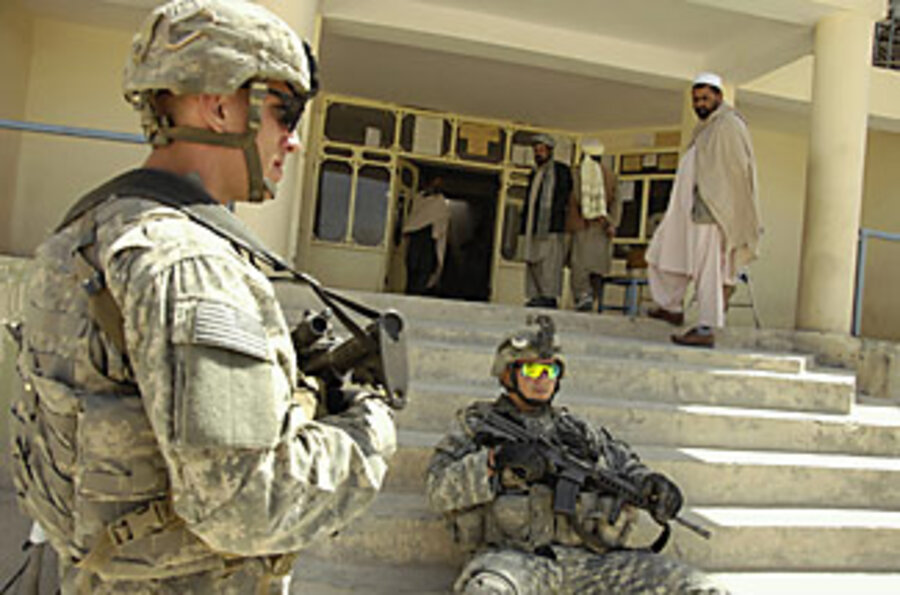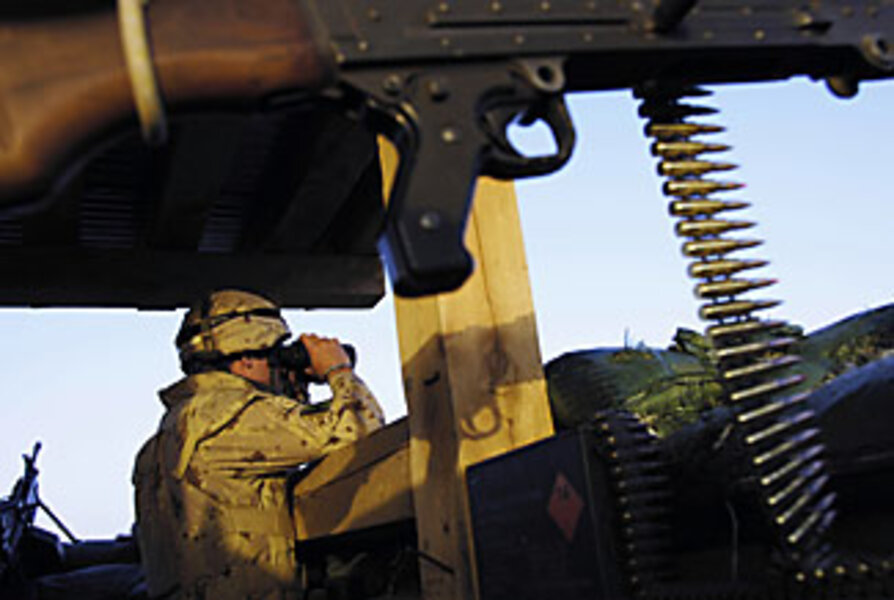U.S. to heighten Afghan role?
Loading...
| Washington
The Pentagon is considering whether it should push to change the NATO mission in volatile southern Afghanistan to give the US greater control in the fight against a growing Taliban threat.
The move is one of many being assessed as fears rise that the collective effort of NATO forces there lacks coherence. The Taliban's comeback over the past two years has been marked by a spike in suicide bombings and other violence – at the same time that critics say the complex command structure governing NATO and US forces has stifled combat and reconstruction efforts.
American officials see a possible answer in modeling the southern region after the east, which falls under NATO but is led by a subordinate US command and viewed as relatively successful.
The issue is not a new one, but has been overshadowed by the need for more forces in Afghanistan. With new commitments by some allies in place, the focus now is on creating more workable relationships on the ground – without conjuring images of "American bullying," as one retired US officer puts it, among allies whose commitments already hang by a slender thread.
All discussion is in "incubation," says a Pentagon official with firsthand knowledge of the situation, and a decision is still some months away.
"This is the sausage being made," says the official, who like others quoted in this article asked not to be named due to the sensitivity of the discussions.
Support for change comes from outside the military as well. "I think there is a strong rationale for making that command and control much more efficient," Seth Jones, a political scientist at the Rand Corp., told a House panel this month. "We have multiple US chains of command that go through European Command, Central Command, Special Operations Command," he said. "I think there are a range of options on the table about making that arrangement more efficient."
NATO took over what was a security-and-stabilization effort, but is now confronting a combat mission in some of the country's most dangerous provinces. The size of the 61,000-member force, about half of which is American, with the rest from 39 countries, remains a major challenge for commanders. Also of concern is their view that troops as well as provincial reconstruction teams can be more responsive to their countries' domestic concerns than to the commanders under whom they technically fall.
But a particularly thorny issue is the frequent rotations of commands. The southern sector rotates a new subordinate coalition command every nine months. The current Canadian commander, for example, will be replaced by a Dutch counterpart by the end of the year. The frequency of change allow the Taliban to exploit the seams of those transitions, critics say.
In contrast, the Americans cast the US-led eastern sector as successful, in part because of the longer tours – 12 to 15 months or more.
"You get American soldiers and their leaders who establish, maintain, and exploit relationships with the terrain, the indigenous people, and their leadership and their enemy to a fare-thee-well," says Gen. Dan McNeill, senior NATO commander based in Kabul.
"Each time you get a change in nationality in one of these commands, the Afghans as well as the international force have to make adjustments," says General McNeill, who believes the overall strategy in Afghanistan is working and that the larger command structure is succeeding. But he acknowledges that the frequency of rotations in the south is "probably not the most helpful."
Many others believe the overall command needs overhaul. "I have to believe that all my instincts and experience tells me that it ain't working well," says one senior American officer with intimate knowledge of the mission.
But requesting that the coalition forces in the south essentially expand on their commitment by extending their forces is not seen as a simple change.
Defense Secretary Robert Gates, typically quick to address issues as they arise, has so far been reluctant to make changes, following the advice of the Pentagon's Joint Staff earlier this year. On Wednesday, Gates said there are always efforts under way to make sure the mission is as effective as possible, but didn't hint at a new approach anytime soon.
"There's been a lot of discussion in this building about whether we have the best possible command arrangements in Afghanistan," he said. "I've made no decisions."
Meanwhile, Afghanistan is as much a political mission as it is a combat and reconstruction one, say military commanders and analysts.
The coalition there is in many ways as important as the mission itself, and is a test of the overall NATO alliance, military commanders and analysts say
"The fact that we have problems with some allies is in no way an indication that we have problems with all the allies," says Anthony Cordesman, a senior fellow at the Center for Strategic and International Studies, a think tank in Washington. "We couldn't have done what we could without them."
Many coalition forces are watching the US closely to gauge the extent of its commitment to the Afghanistan mission. The nomination of Gen. David Petraeus, an expert in counterinsurgency and now the top commander in Iraq, to lead US Central Command could mean a new emphasis on what Afghanistan needs.
Gates has indicated he will send more US forces to Afghanistan some time in 2009, something that depends partly on how many troops are brought home from Iraq. But there is discussion of sending a division headquarters and or an additional brigade there.
At the same time, discussion is ongoing about other options for improving the effectiveness of the command structure, in addition to the US assuming more responsibility in the south. Some Pentagon officials believe that the head of the NATO coalition in Afghanistan, a four-star general, should be "dual-hatted." In addition to reporting to the NATO leadership in Brussels, he should also have a direct link to Washington.
Supporters of this plan believe Washington's direct input would help to bring more unity of effort to the mission. Another, perhaps more politically palatable, option is to add a new American three-star general to oversee all American forces. That commander would serve as a deputy to the NATO commander but would also answer directly to Washington.
David Barno, who retired as a lieutenant general from the Army after serving as the senior American commander in Afghanistan, testified before the same House panel that the loss of the senior US commander who had directly answered to Washington hurts the mission. Now, the senior NATO commander only answers directly to NATO. [Editor's note: The story incorrectly identified David Barno's former title.]
"I think [it is] a disturbing trend again, given the importance of this mission," he said.
Any of these changes would require approval of the NATO alliance.
Other senior military veterans would like to see "tactical areas of responsibility" drawn that would allow the various forces to "own their own battle space." This would allow them to operate as independently as possible from one another unencumbered by the political reluctance of one country or the military bureaucracy of another.
But if the next administration is to eschew the go-it-alone strategy, the US must find a way to create coalitions that rise above the sum of their parts, analysts say. Working with other countries on what amount to basic organizational issues is ultimately the answer, says one retired officer.
"If the nature of future conflict is going to be a coalition, and we have enough recent examples to show that we put troops at risk if we greatly encumber command and control," says one retired officer. "Then you have to come up with a solution to this."






